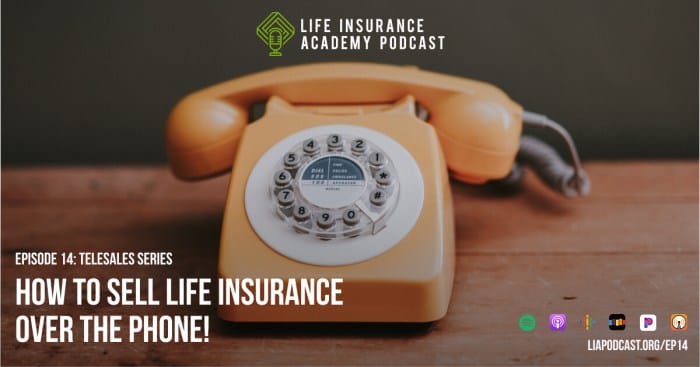In today’s fast-paced world, the ability to sell life insurance over the phone has become an invaluable skill for insurance agents. This sales channel offers unique challenges and opportunities, allowing agents to connect with a broader audience and provide tailored solutions to their clients’ needs.
With the right approach and techniques, selling life insurance over the phone can be a rewarding and fulfilling experience. This comprehensive guide delves into the essential aspects of this sales method, providing valuable tips and strategies to help agents excel in this dynamic field.
Introduction

In today’s fast-paced world, selling life insurance over the phone has become increasingly significant.
This sales channel offers unique advantages, including the ability to reach a wider customer base, enhanced convenience for both the agent and the customer, and cost-effectiveness. However, it also presents challenges such as the lack of face-to-face interaction and the need for effective communication skills.
Challenges
One challenge in selling life insurance over the phone is the lack of face-to-face interaction. This can make it difficult to build rapport with the customer and assess their needs accurately. Additionally, customers may be hesitant to share personal information over the phone, which can hinder the sales process.
Opportunities
Despite these challenges, selling life insurance over the phone also presents several opportunities. The convenience of this sales channel allows agents to reach a wider customer base, including those who may not have the time or inclination to meet in person.
Additionally, phone sales can be more cost-effective for both the agent and the customer, as it eliminates the need for travel and office space.
Pre-Call Preparation

Before reaching out to potential clients, meticulous preparation and research are crucial for successful sales calls. This involves gathering information about their background, current circumstances, and specific insurance needs. By doing so, you can tailor your sales pitch to address their unique concerns and demonstrate how your product aligns with their requirements.
Researching Potential Clients
- Utilize online resources such as social media platforms, company websites, and professional networks to gather publicly available information about potential clients.
- Conduct a thorough analysis of their industry, company size, and recent news or developments that may impact their insurance needs.
- Review their financial statements, annual reports, or other publicly available documents to understand their financial stability and growth prospects.
Understanding Their Needs
- Analyze their current insurance coverage, including policy types, limits, and expiration dates, to identify gaps or areas for improvement.
- Assess their risk profile by considering factors such as their age, health, occupation, and lifestyle habits.
- Research industry trends, regulatory changes, or economic conditions that may influence their insurance requirements.
Crafting a Compelling Sales Pitch
- Develop a compelling opening statement that captures their attention and sets the tone for the conversation.
- Highlight the unique benefits and features of your life insurance product that directly address their specific concerns and needs.
- Use persuasive language and storytelling techniques to create an emotional connection and demonstrate the value of your product.
Building Rapport
Establishing a strong rapport with potential clients over the phone is crucial for successful life insurance sales. Creating a friendly and professional atmosphere during the conversation helps build trust and encourages clients to open up about their needs and concerns.
Active Listening
Demonstrating active listening skills shows clients that you genuinely care about their situation. This includes:
- Paying attention to their words, tone of voice, and body language.
- Asking clarifying questions to ensure understanding.
- Reflecting on what they’ve said to show you’re engaged.
- Avoiding interruptions and distractions.
Empathy and Understanding
Putting yourself in the client’s shoes and understanding their perspective fosters a sense of connection. This involves:
- Showing empathy for their situation.
- Acknowledging their concerns and emotions.
- Validating their feelings without judgment.
- Demonstrating a genuine desire to help.
Personalization
Tailoring the conversation to the client’s individual needs and goals helps them feel valued and understood. This includes:
- Using their name throughout the conversation.
- Referring to specific details they’ve shared.
- Customizing your recommendations based on their unique situation.
- Showing genuine interest in their life and aspirations.
Professionalism and Confidence
Maintaining a professional demeanor while exuding confidence inspires trust and credibility. This includes:
- Speaking clearly and articulately.
- Maintaining a positive and upbeat tone.
- Demonstrating knowledge and expertise in life insurance.
- Handling objections and concerns with grace and professionalism.
Friendliness and Humor
Injecting a touch of friendliness and humor into the conversation can help break the ice and create a more relaxed atmosphere. This includes:
- Sharing appropriate personal anecdotes or experiences.
- Using humor sparingly and appropriately.
- Smiling while you speak (even though the client can’t see you).
- Maintaining a sense of warmth and approachability.
Identifying Client Needs

Establishing the client’s insurance requirements is pivotal in devising a tailored life insurance plan. By employing open-ended inquiries, advisors can unearth these needs and concerns effectively.
Probing Questions:
Advisors should delve into the client’s financial landscape, family dynamics, and risk tolerance using probing questions. These queries provide valuable insights into the client’s circumstances and aspirations.
- Financial Status:
- What is your current annual income?
- Do you have any outstanding debts or loans?
- What are your short-term and long-term financial goals?
- Family Circumstances:
- How many dependents do you have, including spouse and children?
- Are you planning to have more children in the future?
- Who would be responsible for your dependents if you were no longer able to provide for them?
- Risk Tolerance:
- How comfortable are you with taking financial risks?
- Do you prefer guaranteed returns or are you willing to consider investments with higher potential returns but also higher risks?
- Have you ever experienced a significant financial loss in the past?
Active Listening:
Beyond asking questions, advisors must demonstrate active listening skills to fully grasp the client’s perspective. This involves paying close attention to both verbal and non-verbal cues, empathizing with the client’s situation, and avoiding interruptions.
By actively listening, advisors can gain a deeper understanding of the client’s needs and concerns, enabling them to provide tailored recommendations that align with the client’s unique circumstances and aspirations.
Presenting the Product

Presenting life insurance products effectively over the phone requires a clear and organized approach that highlights key benefits and addresses client concerns. HTML table tags provide a structured and visually appealing way to present product information, making it easy for clients to understand and compare different options.
By utilizing HTML table tags, you can create a visually appealing and organized presentation that showcases the key features and benefits of your life insurance products. This makes it easier for clients to understand the different options available and make informed decisions.
Effective Product Presentations
- Use clear and concise language: Avoid jargon and technical terms that may confuse clients. Use simple language that they can easily understand.
- Highlight key features and benefits: Focus on the most important features and benefits of your product that align with the client’s needs and concerns. Use bullet points to make them easy to read and understand.
- Use visual aids: Incorporate charts, graphs, and images to help clients visualize the benefits of your product. This can make your presentation more engaging and memorable.
- Provide personalized recommendations: Tailor your presentation to the client’s specific needs and concerns. Use your knowledge of their situation to recommend the most suitable product and coverage options.
- Address objections and concerns: Be prepared to address any objections or concerns that clients may have. Provide clear and concise answers that demonstrate your expertise and knowledge of the product.
Handling Objections

During a sales call, potential clients may raise objections. These objections can be addressed effectively by remaining calm, empathetic, and using a consultative approach. This approach involves understanding the client’s concerns, providing clear explanations, and offering solutions that align with their needs.
Common Objections and Effective Responses
Some common objections and effective responses include:
- Objection: “I don’t need life insurance; I’m healthy.”
- Response: “While you may be healthy now, life insurance provides financial protection for your loved ones in case of an unexpected event. It ensures they have the resources to maintain their lifestyle and meet financial obligations, regardless of your health status.”
- Objection: “Life insurance is too expensive.”
- Response: “Life insurance premiums can vary depending on factors like age, health, and coverage amount. We can work together to find a plan that fits your budget while providing adequate protection for your family.”
- Objection: “I don’t understand how life insurance works.”
- Response: “I’m here to guide you through the process and explain everything in detail. We can discuss different types of policies, coverage options, and how they can benefit you and your family.”
- Objection: “I’m not convinced that life insurance is worth it.”
- Response: “Life insurance is an investment in your family’s future. It provides peace of mind knowing that your loved ones will be financially secure in case of your untimely demise. Consider the potential financial impact on your family if you were no longer there to provide for them.”
Closing the Sale

Closing the sale is a crucial step in the life insurance sales process, where the agent aims to convince the client to purchase the product. It involves effectively summarizing the benefits of the life insurance product, overcoming any remaining objections, creating a sense of urgency, and asking for the sale confidently.
Summarizing the Benefits
Summarize the key benefits of the life insurance product in a clear and concise manner. Highlight how the product addresses the client’s specific needs and concerns. Use simple language and avoid technical jargon to ensure the client understands the value of the product.
Overcoming Objections
Be prepared to handle any remaining objections the client may have. Listen attentively to their concerns and provide well-thought-out responses that address their specific points. Offer alternative solutions or additional benefits to overcome objections and demonstrate the value of the product.
Creating a Sense of Urgency
Create a sense of urgency by emphasizing the importance of securing life insurance coverage as soon as possible. Explain how delaying the purchase could have negative consequences, such as increased premiums or the risk of not having coverage in case of an unexpected event.
Asking for the Sale
Ask for the sale in a confident and professional manner. Use a direct approach and avoid hesitation or uncertainty. Provide a clear call to action, such as asking the client to sign the application or make a payment. Be prepared to answer any final questions or concerns the client may have.
Following Up

Building a lasting relationship with clients is essential for long-term success in selling life insurance. Following up after the sale is a crucial step in ensuring client satisfaction and fostering a positive relationship.
Personalized Thank-You Notes
- Express gratitude for the client’s trust and business.
- Reiterate the benefits of the policy and how it aligns with their needs.
- Include a handwritten note for a personal touch.
Post-Sale Surveys
- Gather feedback on the sales process and the client’s experience.
- Identify areas for improvement and address any concerns promptly.
- Use surveys to gauge client satisfaction and measure the effectiveness of your sales approach.
Regular Check-Ins
- Schedule regular check-ins to monitor the client’s needs and ensure the policy continues to meet their evolving circumstances.
- Provide updates on policy performance and market trends.
- Use check-ins as an opportunity to identify opportunities for additional sales or referrals.
Identifying Opportunities for Additional Sales or Referrals
- During follow-up calls, inquire about the client’s satisfaction with the policy and their financial goals.
- Identify potential gaps in their coverage or opportunities for upgrading their policy.
- Ask for referrals from satisfied clients to expand your network and generate new leads.
Professional Development
In the dynamic landscape of life insurance sales, continuous learning and professional development are essential for agents who aspire to succeed over the phone. By staying abreast of industry trends, regulations, and product offerings, agents can enhance their sales skills, knowledge, and ability to meet the evolving needs of their clients.
Embracing professional development enables agents to:
- Stay informed about the latest industry trends and regulatory changes.
- Expand their knowledge of insurance products and services.
- Develop stronger sales skills and techniques.
- Enhance their ability to build rapport with clients and identify their needs.
- Increase their earning potential and career opportunities.
Staying Up-to-Date
To stay current, life insurance agents should:
- Read industry publications and attend conferences and workshops.
- Subscribe to online newsletters and blogs to receive updates on industry news and trends.
- Network with other agents and insurance professionals to share ideas and best practices.
- Take advantage of online courses and webinars offered by insurance companies and industry organizations.
Attending Conferences, Workshops, and Webinars
Conferences, workshops, and webinars provide opportunities for agents to:
- Learn about new products and services from insurance companies.
- Network with other agents and industry professionals.
- Attend educational sessions on a variety of topics, such as sales techniques, product knowledge, and regulatory compliance.
- Earn continuing education credits required for maintaining their licenses.
Ethical Considerations

Life insurance agents have an ethical responsibility to uphold the highest standards of integrity, honesty, and professionalism when selling over the phone. Acting in the best interests of the client, avoiding misrepresentation, and adhering to industry regulations and standards are paramount.
Misrepresentation and misleading statements erode trust and can lead to legal consequences. Agents must ensure that all information provided to clients is accurate, clear, and easily understood. High-pressure sales tactics, such as creating a sense of urgency or fear, are unethical and should be avoided.
Acting in the Best Interests of the Client
The primary ethical responsibility of a life insurance agent is to act in the best interests of the client. This means recommending products that meet the client’s needs and financial situation, rather than focusing solely on maximizing sales or commissions.
Adhering to Industry Regulations and Standards
Life insurance agents must adhere to industry regulations and standards set forth by regulatory bodies and professional organizations. These regulations and standards are designed to protect consumers and ensure ethical conduct within the industry.
Avoiding Misrepresentation and Misleading Statements
Agents must avoid misrepresenting or making misleading statements about life insurance products or policies. This includes exaggerating benefits, downplaying risks, or making promises that cannot be kept.
Avoiding High-Pressure Sales Tactics
High-pressure sales tactics, such as creating a sense of urgency or fear, are unethical and should be avoided. Agents should provide clients with ample time to consider their options and make informed decisions.
Last Recap
Selling life insurance over the phone requires a unique blend of communication skills, empathy, and product knowledge. By following the tips and strategies Artikeld in this guide, agents can build strong relationships with clients, identify their needs accurately, and present tailored solutions that provide peace of mind and financial security.
With dedication and continuous learning, agents can master this sales channel and achieve remarkable success in the life insurance industry.
FAQ
What are the key challenges of selling life insurance over the phone?
The primary challenges include establishing rapport without face-to-face interaction, overcoming objections without visual cues, and maintaining engagement throughout the sales conversation.
How can I build rapport with clients over the phone?
Building rapport involves creating a friendly and professional atmosphere, actively listening to their concerns, and demonstrating genuine care for their well-being.
What are some effective strategies for identifying client needs over the phone?
Effective strategies include asking open-ended questions, probing their financial situation and family circumstances, and utilizing active listening skills to fully understand their perspective.
How can I handle objections during a sales call?
Handling objections involves remaining calm and empathetic, providing tailored responses that address their specific concerns, and using a consultative approach to build trust and rapport.
What are some tips for closing the sale over the phone?
Tips for closing the sale include summarizing the benefits of the life insurance product, overcoming any remaining objections, creating a sense of urgency, and asking for the sale in a confident and professional manner.



